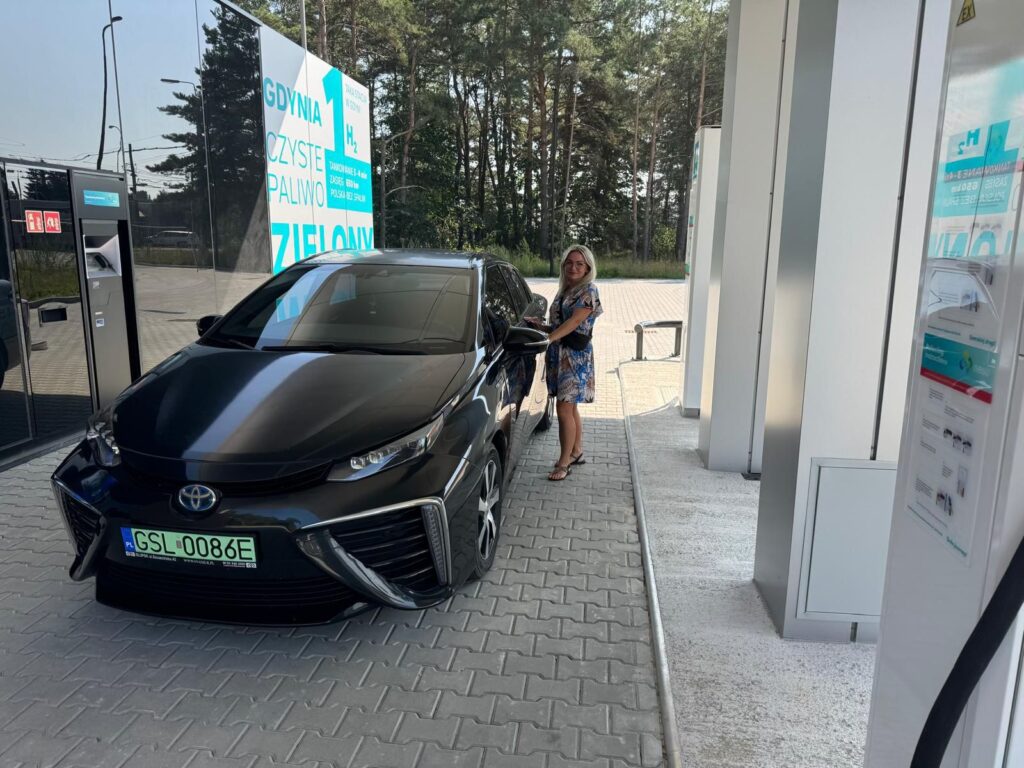Used Toyota Mirai I imported from the USA: When age is just a number, and hydrogen has more energy than coffee on a Monday!
On a warm, sunny afternoon, with the smell of grass in the air, the CBR Future Solutions and ECM team decided to do something that hadn’t been done before – test a used first-generation Toyota Mirai. The vehicle, which had already covered 75 thousand kilometers, bravely faced our most demanding critics – both from the female and male parts of the team. To keep the balance – and avoid potential arguments about the paint color – everyone had their own task: from thoroughly assessing seat comfort to carefully listening for the drive sound. Or rather, its absence, as the Mirai drives almost silently.
8 years old and still shining!
At first glance, it’s clear that the Toyota Mirai didn’t intend to succumb to the passage of time. An eight-year-old car? Most other cars at that age would already have been worn by time. But not the Mirai. From the outside, its lines still look futuristic, and the interior – oh, that interior – resembled more the cockpit of a spaceship than a car that could take part in a cheap holiday in the Podkarpacie region.
“This is really like a ship from ‘Star Wars’! Only R2-D2 is missing,” said our tester, Dorota, before using the touch screen for the air conditioning, which worked just as smoothly as the day it left the factory. It’s worth noting that the Mirai is equipped with technology that many new cars could only dream of.
Refueling – How to Do It Faster Than Coffee
The part of the test we feared most, being people accustomed to the “classic” fuel pumps for gasoline or diesel, and at the same time, a team from an ecosystem based on balancing and storing energy in green hydrogen, turned out to be… lightning fast! Refueling the Toyota Mirai took less time than our standard coffee break (including selecting the right lactose-free milk). The process was simple, clean, and most importantly, quick.
“I don’t know why I was worried it would be more complicated!” said Dorota Janusz – the female member of the testing team, who refueled the Toyota without the slightest problem.
That’s it? Refueling the Mirai is a moment – a bit like putting a capsule into an espresso machine. Except, instead of a caffeine boost, the car gets pure, eco-friendly power. And it’s also environmentally friendly – the only thing it emits is… water.
One might think that after eight years on the road and 75 thousand kilometers on the clock, the Mirai would begin showing signs of wear. Nothing could be further from the truth. The car drives as smoothly as if it just left the showroom – the reliability of the Toyota Mirai made a huge impression on us. It never sputtered, hesitated, or gave us any reason for concern during our tests. However, the refueling infrastructure is still problematic. Fortunately, the ECM ecosystem concept includes equipping every cluster with hydrogen refueling stations. The dispersed network project is labeled with the mysterious working name SHES, and you can read more about it on our website. I’ll just add that the first of our stations will be built in the LAB ONE Energy Cluster in Gniewino.
Modernity in Old Bones
During the test, we were able to see that the Toyota Mirai I, despite its “age,” is still a modern vehicle. It’s not just about the appearance or onboard systems – it’s the whole philosophy behind this car. Eco-friendly, quiet, and dynamic – it’s a car that not only cares about the comfort of its driver but also about the environment, cleaning it as it drives.
Finances
Unfortunately, the cost of purchasing new hydrogen vehicles on the market is significant and deviates from the prices of cars with traditional powertrains. The same applies to the cost of traveling 100 km. Our Toyota in the test, depending on the driver’s style, consumed from 0.8 to 1.4 kg of hydrogen. The average real range is around 400 km. However, this didn’t stop us from testing the Mirai on a longer route. The price we paid for hydrogen at the station was about 69 PLN/kg on average. The conclusions are clear! But let’s look at the situation more broadly – after all, the test car is used, and its cost is 1/3 of a new one. The issue of refueling costs remains, but we have a solution for that. Here, the ECM decentralized energy ecosystem comes to the rescue, where the user can configure their unique energy portfolio and produce it independently. The mechanics of the ecosystem, through the Energy Exchange Platform Tron solution, allows its use in any cluster and any medium, including refueling with green hydrogen.
Summary
We all agreed on the outcome of the test – the Toyota Mirai I is a vehicle that deserves a medal for durability, and it also proved that even a hydrogen car under the hood can be a worthy competitor to younger cars on the market. And when it comes to reliability? The Toyota Mirai showed that in this field, there’s no comparison – age and mileage don’t matter when you’re dealing with such solid engineering.

